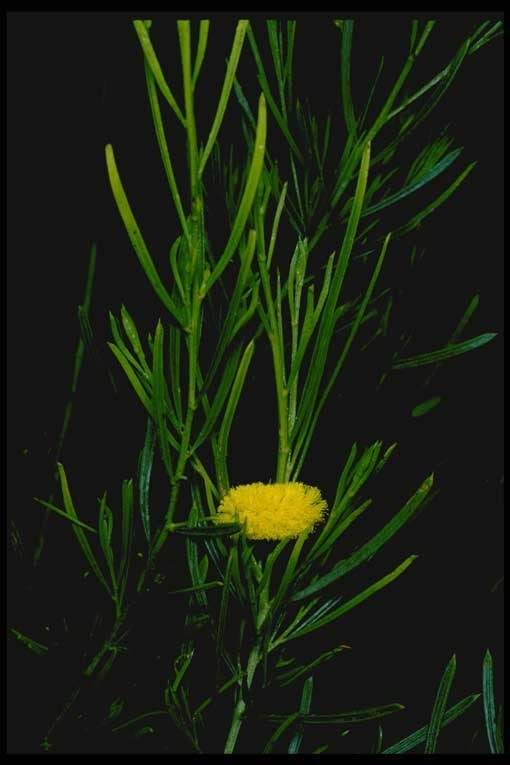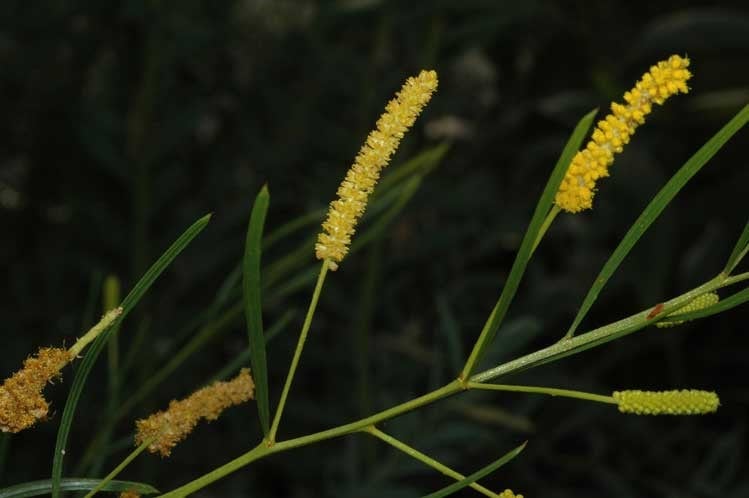Acacia chisholmii F.M.Bailey
WATTLE
Acacias of Australia
Common Name
Chisholm's Wattle, Turpentine Bush
Family
Fabaceae
Distribution
Occurs in western Qld, from 18ºS to 23ºS and westwards to 146ºE; common in the Mount Isa–Cloncurry area. L.Pedley, Proc. Roy. Soc. Queensland 75: 29 (1964), cites a single specimen from near Lake Nash, N.T.
Description
Shrub to 4 m high, multistemmed, spreading, resinous. Bark ‘Minni Ritchi’. Branchlets angular, purplish brown or red-brown, with minutely crenulated, weakly appressed-villous ridges; interstices glabrous, lenticellate. Phyllodes erect, linear, flat, 1.5–5.5 (–7) cm long, 0.7–2 mm wide, with weakly villous margins, pungent-pointed, thinly coriaceous, with 2 prominent raised longitudinal villous nerves, often with 1 subprominent parallel nerve; gland 1, inconspicuous, basal, 2.3–9.5 mm above pulvinus. Spikes 13–28 mm long, golden. Flowers 5-merous; calyx 0.4–1 mm long, dissected to 2/5–3/4, with margins and midribs ±ciliolate; corolla 1.1–1.6 mm long, dissected to less than 1/2, glabrous; ovary scurfy-scaly to villous. Pods linear, ±flat, ±constricted between seeds, curved, 2.5–14 cm long, coriaceous, reticulate; margins pale. Seeds oblique, narrowly oblong-elliptic, 3.6–4.5 mm long, dark brown to black; pleurogram with pitted halo; areole circular to obovate, closed, depressed, dark grey-brown to dark brown.
Phenology
Flowers May–Aug.
Habitat
Grows on stony, often lateritic plains with shallow, sandy soils, on escarpments or in undulating country, in grasslands or eucalypt-spinifex woodland.
Specimens
N.T.: 7 miles [11 km] NW of ‘Lake Nash’, R.A.Perry 918 (CANB, DNA). Qld: 25 km W [of] Cloncurry, G.P.Guymer 496 (NE, NSW); 24 miles [38.4 km] NW of Duchess Township, M.Lazarides 4386 (CANB, MEL, NSW); 40 km N of Georgetown, B.L.Rice 2417 (NSW); 126 km NW of Boulia, T.& J.Whaite 3901 (A, CANB, CHR, NSW).
Notes
The inflorescences are transformed by insects into stellate or pin-cushion-type galls, e.g. M.Lazarides 4386 and G.P.Guymer 496. Details of ecology, utilisation, etc. of A. chisholmii are given in L.J.Thomson & N.Hall, Austral. Acacias no. 25, CSIRO Division of Forestry & Forest Products (1989).
L.Pedley, Austrobaileya 1: 124 (1978), describes the phyllodes and peduncles as glabrous but this is not so in the material (including the isotypes) at NSW; he also states that the spikes are in pairs which is uncommon in the NSW collections.
FOA Reference
Data derived from Flora of Australia Volumes 11A (2001), 11B (2001) and 12 (1998), products of ABRS, ©Commonwealth of Australia
Author
Minor edits by J.Rogers
Dr M.D.Tindale and Dr P.G.Kodela with the assistance of M.Bedward, S.J.Davies, C.Herscovitch, D.A.Keith and/or D.A.Morrison
This identification key and fact sheets are available as a mobile application:
URL: https://apps.lucidcentral.org/wattle/
© Copyright 2018. All rights reserved.














